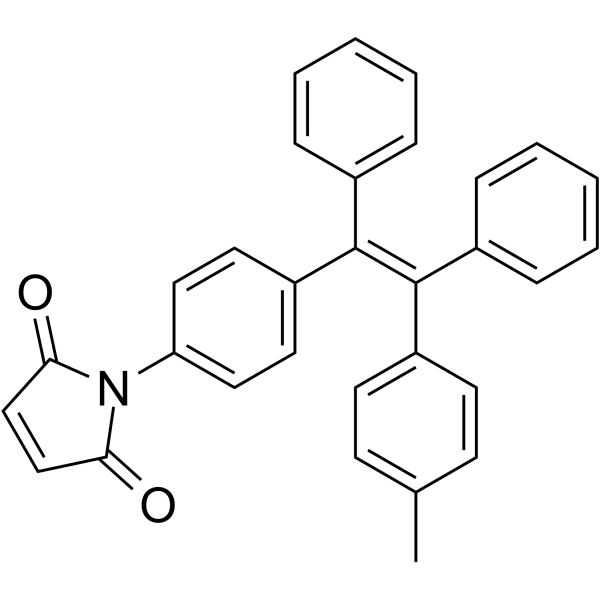1245606-71-6
| Name | TPE-Thiol |
|---|---|
| Synonyms |
1-[4-[2-(4-Methylphenyl)-1,2-diphenylethenyl]phenyl]-1H-pyrrole-2,5-dione
1-{4-[(E)-2-(4-Methylphenyl)-1,2-diphenylvinyl]phenyl}-1H-pyrrole-2,5-dione TPE-Thiol 1H-Pyrrole-2,5-dione, 1-[4-[(E)-2-(4-methylphenyl)-1,2-diphenylethenyl]phenyl]- |
| Description | TPE-MI (Tetraphenylethene maleimide) is a thiol probe for measuring unfolded protein load and proteostasis in cells. TPE-MI can report imbalances in proteostasis in induced pluripotent stem cell models of Huntington disease, as well as cells transfected with mutant Huntington exon 1 before the formation of visible aggregates. TPE-MI also detects protein damage following dihydroartemisinin treatment of the malaria parasitesPlasmodium falciparum [1][2]. |
|---|---|
| Related Catalog | |
| In Vitro | TPE-MI is inherently non-fluorescent until it is conjugated to a thiol via the maleimide. TPE-MI fluorescence is activated upon labelling free cysteine thiols, normally buried in the core of globular proteins that are exposed upon unfolding[1]. TPE-MI (50 µM; 0-60 min) exhibits a homogeneous cytoplasmic labelling pattern in live HeLa cells, with a lower level of labelling in the nucleus and apparent concentration in the region of the ER, which was anticipated as a major location for protein synthesis and folding[1]. At the high expression level, the mutant 97Q form of Httex1 was associated with an elevated TPE-MI fluorescence signal relative to a non-disease-causing 25Q form of Httex1[1]. TPE-MI consists of the aggregation-induced emission (AIE) fluorogen tetraphenylethane (TPE) and the thiol-reactive group maleimide (MI), thereby possessing both AIE phenomenon and selective thiol reactivity[2]. |
| References |
| Density | 1.2±0.1 g/cm3 |
|---|---|
| Boiling Point | 565.7±29.0 °C at 760 mmHg |
| Molecular Formula | C31H23NO2 |
| Molecular Weight | 441.520 |
| Flash Point | 228.0±16.6 °C |
| Exact Mass | 441.172882 |
| LogP | 7.74 |
| Vapour Pressure | 0.0±1.5 mmHg at 25°C |
| Index of Refraction | 1.665 |
| RIDADR | NONH for all modes of transport |
|---|
